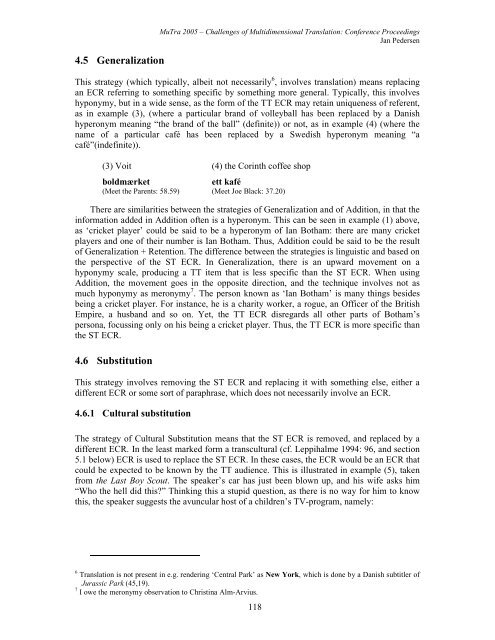Proceedings - Translation Concepts
Proceedings - Translation Concepts
Proceedings - Translation Concepts
You also want an ePaper? Increase the reach of your titles
YUMPU automatically turns print PDFs into web optimized ePapers that Google loves.
4.5 Generalization<br />
MuTra 2005 – Challenges of Multidimensional <strong>Translation</strong>: Conference <strong>Proceedings</strong><br />
Jan Pedersen<br />
This strategy (which typically, albeit not necessarily 6 , involves translation) means replacing<br />
an ECR referring to something specific by something more general. Typically, this involves<br />
hyponymy, but in a wide sense, as the form of the TT ECR may retain uniqueness of referent,<br />
as in example (3), (where a particular brand of volleyball has been replaced by a Danish<br />
hyperonym meaning “the brand of the ball” (definite)) or not, as in example (4) (where the<br />
name of a particular café has been replaced by a Swedish hyperonym meaning “a<br />
café”(indefinite)).<br />
(3) Voit (4) the Corinth coffee shop<br />
boldmærket<br />
ett kafé<br />
(Meet the Parents: 58.59) (Meet Joe Black: 37.20)<br />
There are similarities between the strategies of Generalization and of Addition, in that the<br />
information added in Addition often is a hyperonym. This can be seen in example (1) above,<br />
as ‘cricket player’ could be said to be a hyperonym of Ian Botham: there are many cricket<br />
players and one of their number is Ian Botham. Thus, Addition could be said to be the result<br />
of Generalization + Retention. The difference between the strategies is linguistic and based on<br />
the perspective of the ST ECR. In Generalization, there is an upward movement on a<br />
hyponymy scale, producing a TT item that is less specific than the ST ECR. When using<br />
Addition, the movement goes in the opposite direction, and the technique involves not as<br />
much hyponymy as meronymy 7 . The person known as ‘Ian Botham’ is many things besides<br />
being a cricket player. For instance, he is a charity worker, a rogue, an Officer of the British<br />
Empire, a husband and so on. Yet, the TT ECR disregards all other parts of Botham’s<br />
persona, focussing only on his being a cricket player. Thus, the TT ECR is more specific than<br />
the ST ECR.<br />
4.6 Substitution<br />
This strategy involves removing the ST ECR and replacing it with something else, either a<br />
different ECR or some sort of paraphrase, which does not necessarily involve an ECR.<br />
4.6.1 Cultural substitution<br />
The strategy of Cultural Substitution means that the ST ECR is removed, and replaced by a<br />
different ECR. In the least marked form a transcultural (cf. Leppihalme 1994: 96, and section<br />
5.1 below) ECR is used to replace the ST ECR. In these cases, the ECR would be an ECR that<br />
could be expected to be known by the TT audience. This is illustrated in example (5), taken<br />
from the Last Boy Scout. The speaker’s car has just been blown up, and his wife asks him<br />
“Who the hell did this?” Thinking this a stupid question, as there is no way for him to know<br />
this, the speaker suggests the avuncular host of a children’s TV-program, namely:<br />
6 <strong>Translation</strong> is not present in e.g. rendering ‘Central Park’ as New York, which is done by a Danish subtitler of<br />
Jurassic Park (45,19).<br />
7 I owe the meronymy observation to Christina Alm-Arvius.<br />
118
















